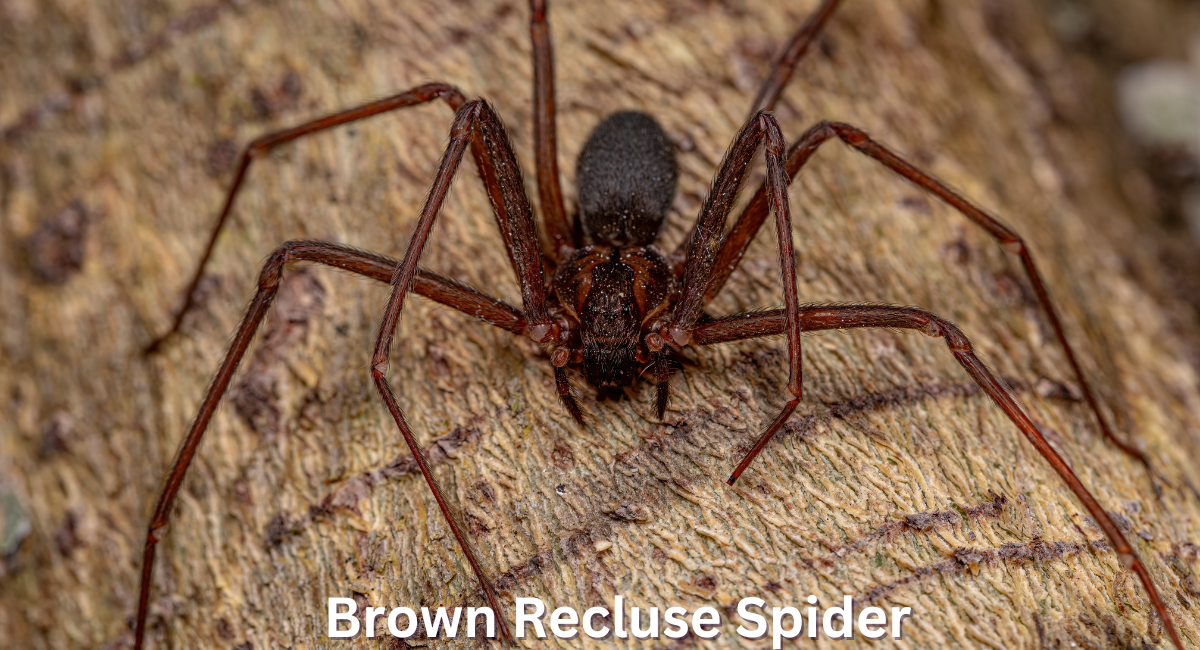The Brown Recluse Spider (Loxosceles reclusa) is easily recognized by the violin-shaped marking on its back. This distinctive feature makes it stand out among spiders. Native to the Midwestern and Southern United States, this reclusive spider has gained notoriety due to its venomous bite. The bite can cause painful reactions and, in rare cases, severe skin damage. Brown Recluse Spiders prefer to seek shelter in dark, quiet areas to avoid disturbances. Because of this, they often reside in basements, closets, attics, and sheds. This preference for habitat means that humans usually encounter them accidentally, typically when they move or disturb items.
Understanding the Brown Recluse Spider’s habitat, behavior, and potential health risks can help prevent dangerous interactions. Although not aggressive, these spiders may bite if they feel threatened. Their venom contains a potent toxin that can lead to symptoms ranging from mild irritation to serious skin lesions. Awareness and preventive measures, such as regular cleaning and sealing entry points, can reduce the chances of an encounter. For those living in regions where these spiders are common, knowing their habits and taking safety precautions can go a long way in minimizing risks.
Identification of the Brown Recluse Spider
The Brown Recluse Spider is recognized by its light brown color. It has a dark, violin-shaped marking on its cephalothorax, which is the part of the body that holds the head and thorax. This unique marking is located just behind the spider’s eyes. It becomes more prominent as the spider matures, making it easier to identify older Brown Recluse Spiders. Adults typically measure between 6 to 20 millimeters in body length. They also have long, slender legs that help them move quickly.
Unlike the Sydney Funnel-Web Spider, which is known for its aggressive nature, the Brown Recluse is more reclusive and shy. It prefers to remain hidden and only comes out to hunt at night.
A distinctive feature of the Brown Recluse Spider is its eye arrangement. While most spiders have eight eyes, the Brown Recluse has only six. These are arranged in three pairs in a semicircle. This six-eyed arrangement, along with the characteristic violin marking, makes the Brown Recluse easy to differentiate from other spiders. Many harmless spiders are often mistaken for the Brown Recluse, leading to unnecessary concern. Knowing how to identify these specific characteristics can help people avoid misidentifying this spider and reduce fear surrounding similar-looking species.
Habitat and Distribution
The Brown Recluse Spider is commonly found in the central and southern regions of the United States. However, it occasionally appears in other areas, particularly indoors. This spider thrives in dry, dark, and undisturbed environments like basements, attics, sheds, and woodpiles. Outdoors, it seeks shelter under rocks, logs, and debris, where it can find shaded and secure areas. Unlike the Black Widow Spider, which often appears in cluttered outdoor spaces, the Brown Recluse Spider is less noticeable, blending into its surroundings and avoiding human contact.
Within homes, Brown Recluse Spiders are often located in secluded areas, such as closets, under furniture, or inside shoes and clothing left unattended on the floor. Their tendency to stay hidden can lead to unexpected encounters when people accidentally disturb their hiding places. Although they can be unsettling to find, Brown Recluse Spiders are generally less aggressive than other species, only biting when they feel threatened. This behavior differs from that of the , which is more likely to defend itself actively when its web is disturbed.
Behavior and Hunting Style
The Brown Recluse Spider is primarily nocturnal and an active hunter. Unlike many other arachnids, it does not rely on webs to capture prey. Instead, the Brown Recluse roams at night, searching for small insects and arthropods. This makes it highly elusive and rare to see during the day. Due to its nocturnal hunting behavior, it remains hidden in secluded areas like dark corners or crevices, staying undetected.
Though often feared, Brown Recluse Spiders actually contribute positively to their ecosystem. As active hunters, they help control insect populations. By reducing the numbers of other insects, they play a crucial role in natural pest management. Unlike some of the deadliest spiders in the world, such as the Sydney Funnel-Web or Black Widow, the Brown Recluse does not leave visible webs. This behavior makes it easy for their presence to go unnoticed. They typically reveal themselves only through accidental encounters or bites. Though rare, these bites can cause significant medical concerns.
The Bite of the Brown Recluse Spider
Health Risks and Symptoms of a Brown Recluse Bite
Symptoms of a Brown Recluse Spider bite may not be immediate and can take several hours to manifest. Initially, victims often report localized pain and itching at the bite site, which can develop into redness and swelling over time. In rare cases, individuals may experience a more severe reaction known as necrotizing arachnidism, where the skin and tissue around the bite deteriorate significantly. This delayed onset of symptoms makes it challenging to identify a Brown Recluse Spider bite quickly, leading to potential complications if left untreated.
While serious complications from a Brown Recluse Spider bite are uncommon, some individuals may experience systemic symptoms such as fever, chills, nausea, or fatigue. These symptoms should prompt immediate medical attention, as they may indicate a more serious reaction to the venom. Timely intervention is crucial in minimizing the potential effects of a Brown Recluse bite and can significantly affect recovery outcomes. Understanding the possible symptoms and their progression is key to ensuring prompt treatment and preventing severe complications from the bite.
How to Prevent Encounters with Brown Recluse Spiders
Reducing encounters with the Brown Recluse Spider involves making both the home and surrounding areas less appealing to these creatures. A good starting point is to clear out cluttered storage spaces such as basements, attics, and garages, as these areas can provide ideal hiding spots for spiders. Regular cleaning and dusting routines are essential, as they help eliminate cobwebs and debris that might attract the Brown Recluse. Additionally, sealing cracks and gaps in walls, floors, and window frames can significantly limit entry points, making it more difficult for these spiders to invade your living space.
Utilizing spider repellents or setting up sticky traps can also aid in monitoring for Brown Recluse Spiders. When working in areas where these spiders are likely to be found, such as woodpiles, storage bins, or less frequented spaces, wear protective gear like gloves and long-sleeved clothing. This precaution can greatly reduce the risk of bites by providing a barrier between the skin and the spider. By implementing these strategies, individuals can effectively minimize the chances of an encounter with the Brown Recluse Spider while ensuring a safer environment for themselves and their families.
Managing Brown Recluse Infestations
Difference Between Brown Recluse and Other Spiders
Many people mistake spiders for the Brown Recluse Spider, especially other brown-colored species such as the Wolf Spider and the Grass Spider. However, the Brown Recluse’s distinct violin marking and six-eye pattern set it apart from these lookalikes. Wolf Spiders tend to be larger with more robust bodies and typically live outdoors, whereas Grass Spiders spin sheet-like webs and do not have the characteristic violin marking. Understanding these differences is essential for accurate identification and helps mitigate unnecessary fear associated with the presence of these spiders.
Recognizing the characteristics of different spiders, including the Brown Recluse Spider, can help avoid unnecessary alarm and potential harm. Misidentification often leads to fear and unwarranted extermination, which can disrupt the ecosystem and negatively impact other beneficial species. Learning to distinguish the Brown Recluse Spider from other harmless species is crucial. This is especially important for people living in areas where spiders are commonly found. By raising awareness and educating people about these spiders, we can coexist more peacefully with nature. It also helps reduce the chances of dangerous encounters.
Role of Brown Recluse Spiders in the Ecosystem
The Brown Recluse Spider contributes significantly to the ecosystem by preying on various insects, effectively helping to control insect populations. By feeding on pests like flies, beetles, and other small insects, Brown Recluse Spiders act as natural pest controllers. This helps maintain a balance in their habitats. Their predatory behavior is especially beneficial in agricultural settings. The presence of these spiders can reduce the need for chemical pest control methods, promoting a more sustainable approach. Their role in the food web underscores the importance of maintaining healthy spider populations in various environments.
While often feared for their venomous bites, the Brown Recluse Spider plays an essential role in maintaining ecological harmony. By encouraging natural pest control methods, communities can foster healthier environments that support biodiversity. Rather than indiscriminately eliminating spiders, it is crucial to understand their ecological value and contributions. Promoting awareness about the benefits of the Brown Recluse Spider can help mitigate fear and encourage coexistence, allowing both humans and spiders to thrive in a balanced ecosystem. Recognizing their importance can lead to better management practices that protect these vital creatures and their role in nature.
Conclusion
The Brown Recluse Spider may have a formidable reputation, but with proper knowledge and precautions, it is possible to coexist with these arachnids safely. They are not aggressive by nature and prefer to remain hidden in dark, undisturbed spaces. By understanding the behavior, habitat preferences, and potential health risks of the Brown Recluse Spider, individuals can make informed decisions. This knowledge helps manage encounters and maintain safe living spaces.
In regions where the Brown Recluse Spider is common, practicing preventive measures is key. Staying informed about their role in the environment fosters a greater appreciation for these often-misunderstood creatures.
The presence of Brown Recluse Spiders highlights the complexity of ecosystems. It also emphasizes the importance of each species, even those that may evoke fear, in preserving ecological balance.



